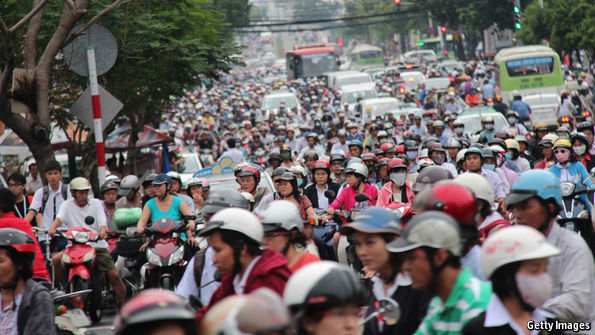
CARS and motorbikes are banned from the old heart of Hoi An, a pretty tourist town in central Vietnam. When the country’s newish prime minister paid a visit, he obligingly travelled on foot. But as Nguyen Xuan Phuc strode manfully around, his motorcade crept along behind him. Outraged netizens disseminated photos of the incident, forcing Mr Phuc to apologise—a rare step for a senior official in Vietnam’s authoritarian regime.
Not many Vietnamese can afford a fleet of blacked-out saloons. But car-ownership in the Communist country is soaring, bringing worries about pollution and congestion. Sales of cars, vans and lorries rose 55% by volume in 2015, albeit from a low base; so far this year they are up another third. Most went to Hanoi and Ho Chi Minh City, which between them house about half of Vietnam’s urban population.
Compared with its choked neighbours, Vietnam’s big cities are relatively uncongested. The country’s 40m or so motorbikes terrify pedestrians, but can thunder 10-abreast along thoroughfares as well as worm down dark alleyways. Cars, by contrast, block up the pipes. Only 9% of land in the heart of Hanoi is given over to primary and secondary roads, compared with 32% in Manhattan. The World Bank in 2011 calculated that if car-use were to reach even the moderate level seen in neighbouring Malaysia, Vietnam’s capital would grind to a halt.
The government is conflicted, says Arve Hansen, an academic. It champions the local car-assembly industry but also slaps stiff taxes on buyers, in part for fear of jams. A suite of recent trade deals will eventually limit authorities’ power to control car-use through tariffs. A pact with South-East Asian neighbours, which comes into full force in 2018, could see cheap cars pour in from Thailand.
The appeal of buying a car may grow even as Vietnam’s roads clog up. The growing risk of collision with a car is making motorcycling more dangerous. Motorists who know they will end up in jams prefer to do it in air-conditioned vehicles than perched on sweaty bike seats. Longer travel times are also putting Vietnamese off buses, which were anyway hot and unreliable. Use of Hanoi’s underfunded public buses has dropped 14% in a year.
New urban rail systems should help. The first of at least six metro lines is under construction in Ho Chi Minh City; two elevated railways are being built in Hanoi. But it will take years to complete these networks, and the fast-growing cities they will serve are transforming as they are built. Hanoi in particular is sprawling, helped along by policies that encourage local authorities to build outward, rather than up.
City officials are making do. Bigwigs in Ho Chi Minh City talk of narrowing pavements to widen roads; Hanoi insists more and better buses are revving up. In June cadres in the capital said they thought improvements in public transport would eventually allow them to ban Hanoi’s 5m motorbikes from downtown areas. It would be better to ban cars.
